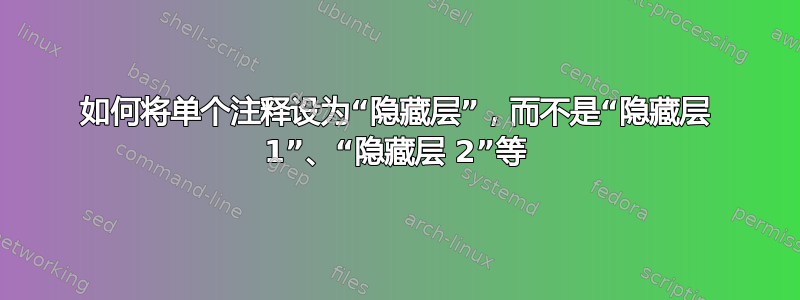
所以我想注释“隐藏层位于我的两个隐藏层的上方和中心,但我没有用我的代码实现它:
\documentclass{article}
\usepackage[utf8]{inputenc} % Codificacao do documento (conversão automática dos acentos)
\usepackage{tikz}
\begin{document}
\pagestyle{empty}
\def\layersep{2.5cm}
\begin{tikzpicture}[shorten >=1pt,->,draw=black!50, node distance=\layersep]
\tikzstyle{every pin edge}=[<-,shorten <=1pt]
\tikzstyle{neuron}=[circle,fill=black!25,minimum size=17pt,inner sep=0pt]
\tikzstyle{input neuron}=[neuron, fill=gray!50];
\tikzstyle{output neuron}=[neuron, fill=red!50];
\tikzstyle{hidden neuron}=[neuron, fill=cyan!65];
\tikzstyle{annot} = [text width=5em, text centered]
% Draw the input layer nodes
\foreach \name / \y in {1,...,2}
% This is the same as writing \foreach \name / \y in {1/1,2/2,3/3,4/4}
\node[input neuron, pin=left:Entrada $x_{\y}$] (I-\name) at (0,-\y) {$x_{\y}$};
% set number of hidden layers
\newcommand\Nhidden{2}
% Draw the hidden layer nodes
\foreach \N in {1,...,\Nhidden} {
\foreach \y in {1,...,3}
\path[yshift=0.5cm]
node[hidden neuron] (H\N-\y) at (\N*\layersep,-\y cm) {};
;
\node[annot,above of=H\N-1, node distance=1cm] (hl\N) {Camada \\ intermediária \N};
}
% Draw the output layer node
\foreach \name / \y in {1}
\path[yshift=-0.5cm]
node[output neuron,pin={[pin edge={->}]right:Saída {$y_{\y}$}}, right of=H\Nhidden-3] (O-\name) at (\Nhidden*\layersep,-\y cm) {$y_{\y}$};
% Connect every node in the input layer with every node in the
% hidden layer.
\foreach \source in {1,...,2}
\foreach \dest in {1,...,3}
\path (I-\source) edge (H1-\dest);
% connect all hidden stuff
\foreach [remember=\N as \lastN (initially 1)] \N in {\Nhidden}
\foreach \source in {1,...,3}
\foreach \dest in {1,...,3}
\path (H\lastN-\source) edge (H\N-\dest);
% Connect every node in the hidden layer with the output layer
\foreach \source in {1,...,3}
\foreach \dest in {1}
\path (H\Nhidden-\source) edge (O-\dest);
% Annotate the layers
\node[annot,left of=hl1] {Camada de entrada};
\node[annot,right of=hl\Nhidden] {Camada de saída};
\end{tikzpicture}
% End of code
\end{document}
答案1
首先,删除/注释掉生成“隐藏层”标签的行。
在图的末尾,即制作输入/输出标签的地方,将代码修改为以下内容:
\path (H1-1) -- node[above=5mm] (hl) {Hidden layers} (H2-1);
\node[annot] at (hl-|I-1) {Camada de entrada};
\node[annot] at (hl-|O-1) {Camada de saída};
第一行将一个节点放置在每个隐藏层中第一个节点中间点上方 5mm 的位置。对于最后两行,坐标指定为(hl -| I-1)表示 y 坐标为hl、 x 坐标为 的点I-1。
不相关的注释:\tikzstyle我认为已被弃用,因此我将样式规范移至环境的参数tikzpicture。
\documentclass{article}
\usepackage[utf8]{inputenc} % Codificacao do documento (conversão automática dos acentos)
\usepackage{tikz}
\begin{document}
\pagestyle{empty}
\def\layersep{2.5cm}
\begin{tikzpicture}[
shorten >=1pt,->,draw=black!50, node distance=\layersep,
every pin edge/.style={<-,shorten <=1pt},
neuron/.style={circle,fill=black!25,minimum size=17pt,inner sep=0pt},
input neuron/.style={neuron, fill=gray!50},
output neuron/.style={neuron, fill=red!50},
hidden neuron/.style={neuron, fill=cyan!65},
annot/.style={text width=5em, text centered}
]
% Draw the input layer nodes
\foreach \name / \y in {1,...,2}
% This is the same as writing \foreach \name / \y in {1/1,2/2,3/3,4/4}
\node[input neuron, pin=left:Entrada $x_{\y}$] (I-\name) at (0,-\y) {$x_{\y}$};
% set number of hidden layers
\newcommand\Nhidden{2}
% Draw the hidden layer nodes
\foreach \N in {1,...,\Nhidden} {
\foreach \y in {1,...,3}
\path[yshift=0.5cm]
node[hidden neuron] (H\N-\y) at (\N*\layersep,-\y cm) {};
;
% \node[annot,above of=H\N-1, node distance=1cm] (hl\N) {Camada \\ intermediária \N};
}
% Draw the output layer node
\foreach \name / \y in {1}
\path[yshift=-0.5cm]
node[output neuron,pin={[pin edge={->}]right:Saída {$y_{\y}$}}, right of=H\Nhidden-3] (O-\name) at (\Nhidden*\layersep,-\y cm) {$y_{\y}$};
% Connect every node in the input layer with every node in the
% hidden layer.
\foreach \source in {1,...,2}
\foreach \dest in {1,...,3}
\path (I-\source) edge (H1-\dest);
% connect all hidden stuff
\foreach [remember=\N as \lastN (initially 1)] \N in {\Nhidden}
\foreach \source in {1,...,3}
\foreach \dest in {1,...,3}
\path (H\lastN-\source) edge (H\N-\dest);
% Connect every node in the hidden layer with the output layer
\foreach \source in {1,...,3}
\foreach \dest in {1}
\path (H\Nhidden-\source) edge (O-\dest);
% Annotate the layers
\path (H1-1) -- node[above=5mm] (hl) {Hidden layers} (H2-1);
\node[annot] at (hl-|I-1) {Camada de entrada};
\node[annot] at (hl-|O-1) {Camada de saída};
\end{tikzpicture}
% End of code
\end{document}



